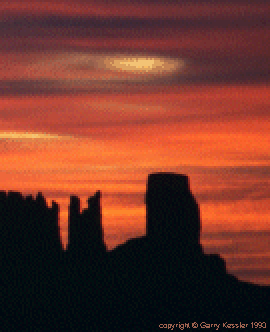 |  | |
There are many different image file formats with varying capabilities used in different applications. Images are usually captured and processed in loss-less formats, such as TIFF. Loss-less formats insure that no information is inadvertently lost from the image when it's captured or during its processing. However, TIFF files are usually too large for Web posting and TIFF format is not supported by Web browsers. JPEG is generally preferred for posting photo-realistic images on the Web.
JPEG is supported by Web browsers, can represent millions of colors for photo-realistic images, and uses file compression to produce small files suitable for fast Web downloads. However, JPEG compression uses a lossy technique, which discards some information from an image. Nevertheless, by judiciously compressing images, significant reductions in file size can be obtained with minimal losses to image quality. For these reasons, JPEG is the format of choice for posting photography on the Web.
Web browsers also support GIF format, which also produces small, downloadable image files. GIF uses a lossless compression technique, which does not lose any data in the image but usually results in larger files than JPEG images. However, because GIF is restricted to a color palette of only 256 colors, it is more suitable for displaying diagrams and black and white photography and generally is not used for photo-realistic color images. The effect of reducing the color palette to only 256 colors is often noticeable in color photographs. In the sample below the effect is particularly noticeable in the light spot in the upper central part of the image.
 |  | |
For this reason JPEG is generally preferred for photo-realistic images.
In summary, images are usually captured and processed in a loss-less format, like TIFF. They're converted to a lossy format, like JPEG, and saved only as a final step.
| Top | Home / Contact | |
Copyright © Garry K. Kessler, 1999-2001. | ||